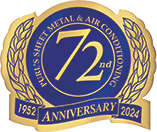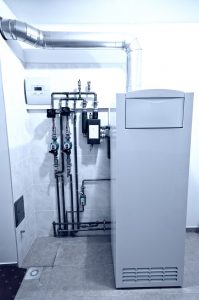Gas furnaces work on a basic principle: lit gas flames heat air that is blown through the furnace and into the rooms through ductwork. But gas furnaces are complex devices that have several safety features and mechanisms that allow them to work correctly and without creating hazards.
One of the key components for the operation of a furnace is the furnace limit switch. You don’t need to know all the details about this part, but understanding the basics will help you know more about how your furnace works—and why it sometimes doesn’t work.
The Basic Function of the Furnace Limit Switch
The furnace limit switch, sometimes called the furnace fan limit switch, is a switch that turns on and off the furnace blower assembly. The switch senses temperatures within the furnace and activates or deactivates the blower based on them. The limit switch is located just below the plenum where it can easily monitor the interior furnace temperature.
The purpose of the furnace limit switch is to coordinate the blower assembly with the burners in the furnace, which prevents uneven heating and drafts indoors, and to shut the furnace off in case of overheating. Stopping the furnace from overheating isn’t only to prevent danger to people in the house, but also prevent damage to the furnace’s other components.
The Furnace Limit Switch in Operation
Let’s go through a basic furnace heating cycle to show the important job of the limit switch during standard operation.
When the thermostat makes a request for heating to the furnace, the control board activates the gas flow to the burners and the ignition system to light them. At this point, the fan won’t have yet come on. The limit switch monitors the heat in the plenum until it has reached 20° more than current room temperature. The switch then activates the blower assembly and begins pushing air into the furnace and around the heat exchanger. The heat exchanger contains all the hot gas drawn from the gas jets and transfers this heat from its metal surface to the air. The heated air continues into the ductwork.
Once the thermostat registers the house interior has reached its target temperature, it signals the control board to shut off the gas to the burners. The blower fan will remain on, however, as the air still needs to help the heat exchanger cool down. The limit switch detects when the exchanger has reached a safe temperature, then shuts off the blower assembly.
The standard temperature settings for a furnace limit switch:
- 200°F — Shut off the burner (the furnace is getting too hot)
- 130°F — Shut off the blower
- 100°F — Turn the blower back on
Can the Limit Switch Malfunction?
Unfortunately, yes, although with regular maintenance for your furnace you’ll rarely have this problem. Usually, a faulty limit switch won’t place your home or furnace in immediate danger, but it will cause the fan to turn on and off at strange times, or run without stopping. If you notice issues with the blower fan or your furnace running too long, we recommend calling us for repairs.
Purl’s Sheet Metal & Air Conditioning offers furnace service, from new gas furnace installation to fast and effective repairs. Call us today: Uncompromised Quality & Customer Service Since 1952.


